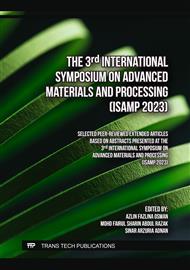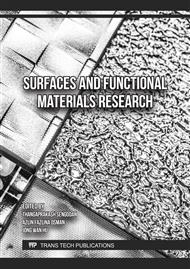[1]
O'Regan, B., & Grätzel, M. (1991). A low-cost, high-efficiency solar cell based on dye-sensitized colloidal TiO2 films. Nature, 353(6346), 737–740.
DOI: 10.1038/353737a0
Google Scholar
[2]
Dissanayake, M. A. K. L., Kumari, J. M. K. W., Senadeera, G. K. R., Jaseetharan, T., Weerasinghe, J., & Anwar, H. (2021). A low-cost, vein graphite/tin oxide nanoparticles based composite counter electrode for efficient dye-sensitized solar cells. Materials Science and Engineering: B, 273, 115440.
DOI: 10.1016/j.mseb.2021.115440
Google Scholar
[3]
Zhang, J., Wang, Z., Li, X., Yang, J., Song, C., Li, Y., Cheng, J., Guan, Q., & Wang, B. (2019). Flexible Platinum-Free Fiber-Shaped Dye Sensitized Solar Cell with 10.28% Efficiency. ACS Applied Energy Materials, 2(4), 2870–2877.
DOI: 10.1021/acsaem.9b00207
Google Scholar
[4]
Yang, S., Zhu, S., & Hong, R. (2020). Graphene oxide/polyaniline nanocomposites used in anticorrosive coatings for environmental protection. Coatings, 10(12), 1–11.
DOI: 10.3390/coatings10121215
Google Scholar
[5]
Mutalib, T. N. A. B. T. A., Tan, S. J., Foo, K. L., Liew, Y. M., Heah, C. Y., & Abdullah, M. M. A. B. (2020). Properties of polyaniline/graphene oxide (PANI/GO) composites: effect of GO loading. Polymer Bulletin, 0123456789.
DOI: 10.1007/s00289-020-03334-w
Google Scholar
[6]
Mohammed, H. Y., Farea, M. A., Sayyad, P. W., Ingle, N. N., Al-Gahouari, T., Mahadik, M. M., … Shirsat, M. D. (2021). Selective and sensitive chemiresistive sensors based on polyaniline/graphene oxide nanocomposite: A cost-effective approach. Journal of Science: Advanced Materials and Devices.
DOI: 10.1016/j.jsamd.2021.08.004
Google Scholar
[7]
López-Díaz, D., Delgado-Notario, J. A., Clericò, V., Diez, E., Merchán, M. D., & Velázquez, M. M. (2020). Towards Understanding the Raman Spectrum of Graphene Oxide: The Effect of the Chemical Composition. Coatings, 10(6), 524.
DOI: 10.3390/coatings10060524
Google Scholar
[8]
Patil, K., Rashidi, S., Wang, H., & Wei, W. (2019). Recent progress of graphene-based photoelectrode materials for dye-sensitized solar cells. International Journal of Photoenergy, 2019.
DOI: 10.1155/2019/1812879
Google Scholar
[9]
Gao, P., Li, A., Sun, D. D., & Ng, W. J. (2014). Effects of various TiO2 nanostructures and graphene oxide on photocatalytic activity of TiO2. Journal of Hazardous Materials, 279, 96–104.
DOI: 10.1016/j.jhazmat.2014.06.061
Google Scholar
[10]
Yu, H., Zhang, S., Zhao, H., Will, G., & Liu, P. (2009). An efficient and low-cost TiO2 compact layer for performance improvement of dye-sensitized solar cells. Electrochimica Acta, 54(4), 1319–1324.
DOI: 10.1016/j.electacta.2008.09.025
Google Scholar
[11]
Kumari, J. M. K. W., Senadeera, G. K. R., Weerasinghe, A. M. J. S., Thotawatthage, C. A., & Dissanayake, M. A. K. L. (2020). Effect of polyaniline (PANI) on efficiency enhancement of dye-sensitized solar cells fabricated with poly(ethylene oxide)-based gel polymer electrolytes. Journal of Solid State Electrochemistry, 25(2), 695–705.
DOI: 10.1007/s10008-020-04841-6
Google Scholar
[12]
Teng, Y., Li, S., Xue, C., Zhang, H., Zhu, L., & Tang, Y. (2020). Synthesis of Polyaniline/Graphene Oxide/Azobenzene Composite and Its Adjustable Photoelectric Properties. Advances in Polymer Technology, 2020, 1–9.
DOI: 10.1155/2020/8730852
Google Scholar
[13]
Yang, S., Zhu, S., & Hong, R. (2020). Graphene Oxide/Polyaniline Nanocomposites Used in Anticorrosive Coatings for Environmental Protection. Coatings, 10(12), 1215.
DOI: 10.3390/coatings10121215
Google Scholar



